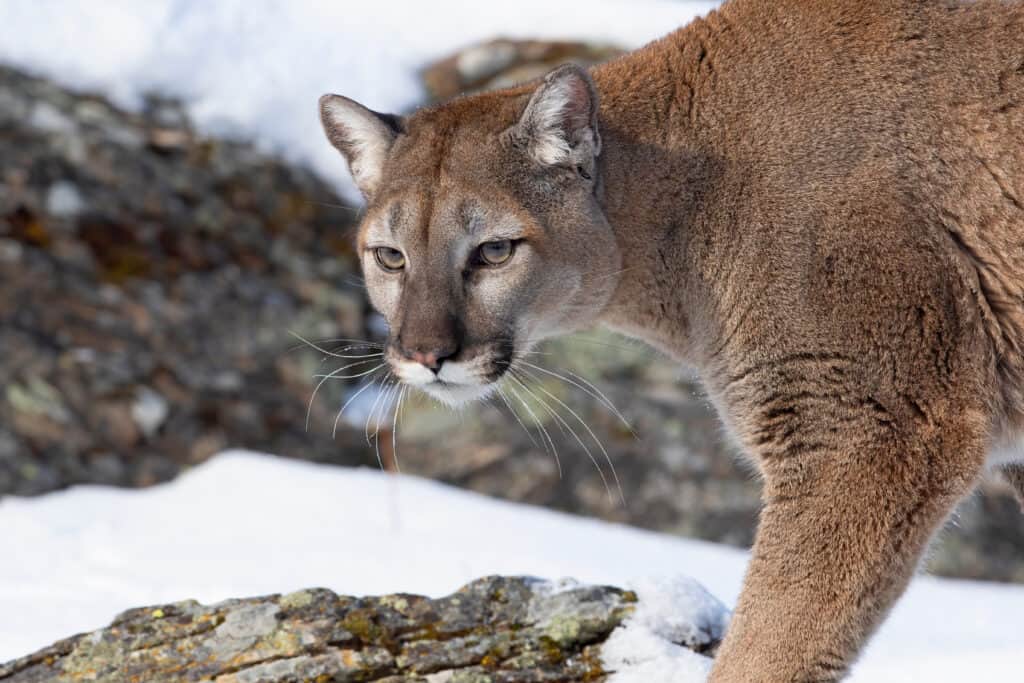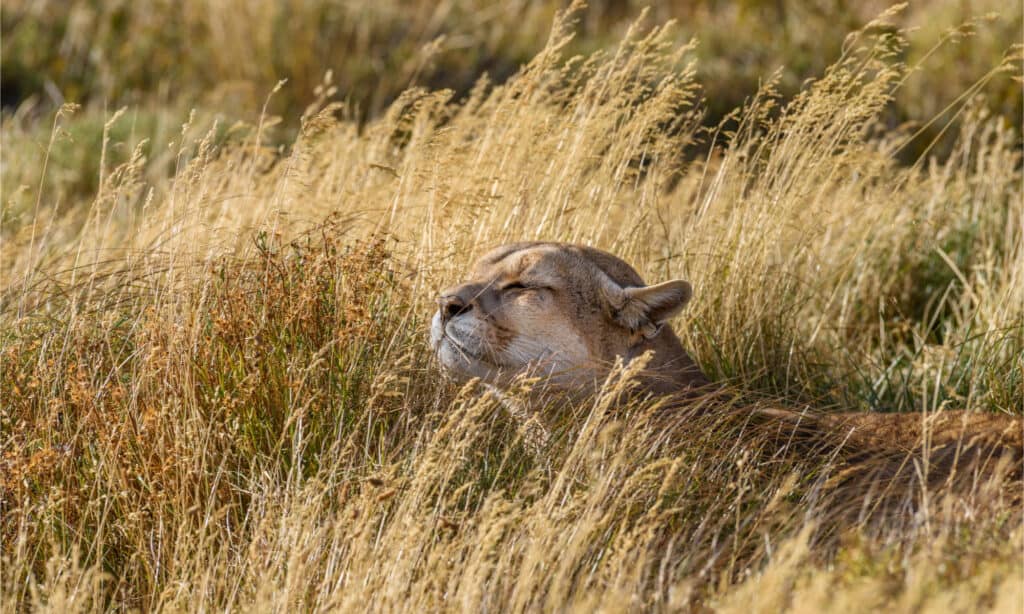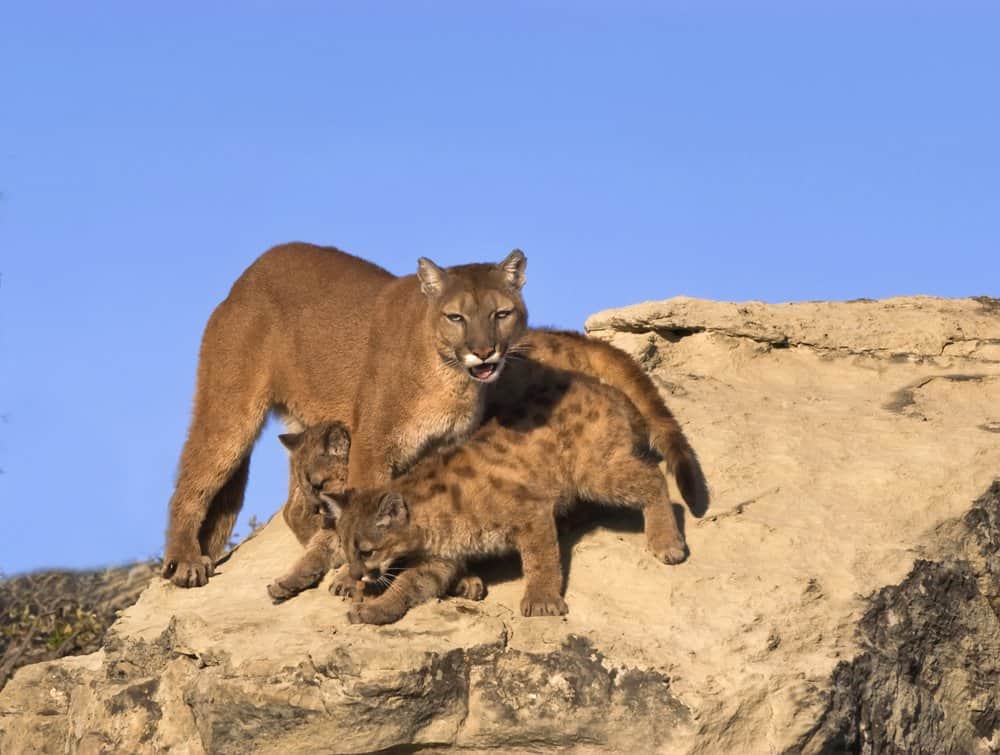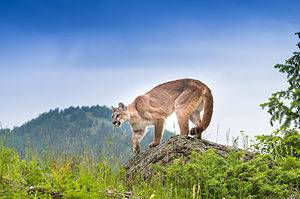You have seen them in the movies. And you have likely read stories about mountain lion attacks on people. So, it may feel like mountain lions are everywhere. However, there are far fewer mountain lions than one might think. The chances of you running into one are slim, especially since they are a stealthy predator. But if that’s the case, where might you see them? In the article below, we explore the areas where mountain lions live.
Keep reading to discover all you ever wanted to know about the habitat of these impressive big cats.
What Are Mountain Lions?
Before diving into a detailed look at the habitat of mountain lions, it will help to understand what exactly they are. These big cats are mammals with the official scientific classification Puma concolor. Depending on which part of the country (or world) you live in, you may know them by cougars, catamounts, panthers, or pumas.
Their large bodies primarily have tan or beige fur. However, they do have a white/gray chest and white/gray bellies. Typically, they have black accents on the tip of their tails, around their eyes, edges of their ears, and snouts.
Their size varies based on which area of the world they live in. But, generally, females are smaller and weigh 64 to 141 pounds. The larger males usually weigh anywhere from 115 to 220 pounds.
Mountain lions are carnivores. Their preferred prey is elk and deer. However, they occasionally hunt smaller animals, such as rabbits or coyotes. They are what is known as an umbrella species. Since they require a large territory, the conservation of mountain lions leads to the protection of other wildlife species and plant life.
They are a solitary species and come together primarily to mate or when females are raising young cubs.

Mountain lions are large and almost entirely tan.
©Jim Cumming/Shutterstock.com
Mountain Lion Habitat
If an area has ample prey, you may find mountain lions there. They are less discriminatory about their physical habitat than about living in a region with abundant food. Therefore, you may find mountain lions in deserts, mountains, forests, and wetlands. You may spot a mountain lion at sea level. Or up closer to the tree line, as they often roam as high as 10,000 feet above sea level.
Mountain lions are not as abundant in the wild as they used to be. That is in large part due to the destruction of their natural habitats. As the population has grown, urban areas have begun encroaching upon the habitats of mountain lions.
These days mountain lions in the United States prefer mountainous or rocky terrain. They love regions with some underbrush or spots for them to hide. And their territorial range is quite large. Adult females typically have a territory between 20 and 60 square miles. But males roam further. They cover territory closer to 100 square miles in size.

Mountain lions live in nearly every environment.
©Chris Desborough/Shutterstock.com
Where Do Mountain Lions Live Around the World?
This large cat species is native to Central, South, and North America. No other mammal living in the Americas has such a huge range. You can find mountain lions as far north as the Yukon. And as far south as The Strait of Magellan.
Part of the reason they have such a broad range is that they are solitary animals. And they are extremely territorial.
Mountain Lions in the United States
Due to hunting practices in the early 1900s and habitat loss, mountain lions are not found in as many locations as they once were. According to the Mountain Lion Foundation, they are now only found in 15 states. However, there are a few pockets of mountain lions east of the Rocky Mountains. Conservationists are working to ensure they can survive.
The Florida panther (Puma concolor coryi) is the largest population of mountain lions in the eastern United States. And it is endangered.

Florida Panthers are endangered.
©jo Crebbin/Shutterstock.com
Mountain Lions in the Americas
According to the Nature Conservancy, only roughly 50,000 mountain lions are left globally. Since there are an estimated 30,000 mountain lions in the United States, only about 20,000 are in the rest of the Americas.
The majestic cats are officially on the endangered species list in Canada.
And down south, the South American cougar (Puma concolor concolor) calls Argentina, Venezuela, Colombia, Chile, Bolivia, and Peru home.
Additionally, mountain lions live throughout all of Central America. You will find them in Honduras, Panama, Belize, El Salvador, Costa Rica, Nicaragua, and Guatemala.

Pumas are found as far south as Chile.
©Danita Delimont/Shutterstock.com
The Historic Range of Mountain Lions
Throughout most of history, the Americas were teaming with mountain lions. There were many subspecies identified in all parts of North and South America. However, as settlers started expanding, they feared for the safety of their livestock and began hunting them. Due to that excessive hunting, mountain lions rapidly became endangered.
Conservationists worked hard to rebuild the mountain lion population. Due to their efforts, now, approximately 30,000 mountain lions live throughout the United States. But despite the slow resurgence of the mountain lion population, it is still significantly lower than its estimated historical levels.
Unfortunately, not all mountain lions survived the purge in the late 1800s and early 1900s. One subspecies, the eastern cougar, is extinct. And the Florida panther only has approximately 160 animals remaining in the wild.

Conservationists are working to restore the mountain lion population.
©outdoorsman/Shutterstock.com
How to Avoid Getting Attacked by a Mountain Lion
Mountain lion attacks on people are relatively rare. However, as more people venture onto trails and into the wilderness, the number of attacks has increased in recent years. Additionally, those attacks often get reported sensationally in newspaper headlines.
And while rare, it is important to exercise caution when pursuing outdoor activities in mountain lion territory.
The US Forest Service (and state and local wildlife officials) posts regular notices of mountain lion sightings. Keep an eye out and stay abreast of local mountain lion activity before you go into wilderness areas. Of course, the best prevention is avoiding areas that have recent sightings.
However, if you do choose to venture out anyway, there are a few steps you can take. Hike in a group and keep any small children close to you. Animals tend to get drawn to smaller human beings. If you see a mountain lion, pick up any smaller kids to help them appear bigger. Avoid hiking at dusk or dawn, as these are prime hunting times.
If you see one, don’t approach it. Additionally, do not run away. Running triggers predatory instincts in large mammals. Rather than crouching down, raise your arms to appear as large as possible. And, in the worst-case scenario, fight back for all your worth if one attacks.

Never run from a mountain lion.
©Chris Alcock/Shutterstock.com
The photo featured at the top of this post is © Evgeniyqw/Shutterstock.com
Sources
- National Wildlife Federation, Available here: https://www.nwf.org/Educational-Resources/Wildlife-Guide/Mammals/Mountain-Lion
- National Geographic for Kids, Available here: https://kids.nationalgeographic.com/animals/mammals/facts/mountain-lion
- Mountain Lion Foundation, Available here: https://mountainlion.org/about-mountain-lions/#!ecological-role
- US Forest Service, Available here: https://www.fs.usda.gov/visit/know-before-you-go/mountain-lions#:~:text=Their%20usual%20habitat%20is%20steep,level%20to%2010%2C000%2Dfoot%20elevations
FAQs (Frequently Asked Questions)
Are there mountain lions in Mexico?
Yes, there are cougars in Mexico!
Do black mountain lions exist?
That question is common and understandable since the phrase “black panther” is ubiquitous. However no, there are no confirmed cases of a black mountain lion in existence.
Will a mountain lion stalk a human?
Mountain lions are predators and exceptional hunters. They are known for their silent stalking ability. However, humans are not their usual food. Most often, attacks on humans come when a mountain lion feels threatened. Other times, young juveniles may attack due to hunger. Follow proper safety guidelines when enjoying outdoor recreation in mountain lion territory.
Thank you for reading! Have some feedback for us? Contact the AZ Animals editorial team.






